Factors Impacting Mumbai Apartment Prices
Explore the primary factors influencing flat prices in Mumbai, including location, amenities, construction quality, and market trends. Learn how urbanization, developer reputation, and government policies shape real estate costs in this bustling metropolis. A comprehensive guide for prospective buyers and investors.

Mumbai attracts many for its career opportunities and lifestyle, but real estate prices are notoriously high. The cost of 1, 2, and 3-bedroom flats is often prohibitive for average buyers. Several factors contribute to these elevated prices, including location, amenities, construction quality, layout, market trends, urban density, developer reputation, and regulatory policies.
Location: Prime areas like Worli, Andheri, Malabar Hill, Juhu, and Bandra command premium prices, sometimes reaching around 57,000 INR per sq.ft., due to proximity to business districts, schools, and social amenities. Less central areas are more affordable.
Amenities: High-end facilities such as swimming pools, gyms, landscaped gardens, and security systems significantly boost property value. Gated communities with advanced safety features are especially sought after.
Construction Quality: Premium materials like marble flooring, glass walls, and high-grade steel increase costs, but also enhance aesthetic appeal and value.
Layout and Size: Developers offer flats in various configurations, with 1BHKs around 400-600 sq.ft., 2BHKs up to 700 sq.ft., and 3BHKs around 900 sq.ft. Prices vary based on size and location.
Market and Economic Factors: Inflation, GDP growth, interest rates, and government policies influence property prices. Monitoring these helps investors make informed decisions.
Urbanization and Space Scarcity: Dense population leads to vertical construction, with high-rise apartments becoming the norm, pushing prices upward due to limited land availability.
Reputation of Developers: Established developers known for timely delivery and quality construction tend to charge higher prices, attracting buyers willing to pay a premium for reliability and aesthetics.
Government Regulations: Policies like FSI limits, GST, and stamp duty impact pricing. Urban planning initiatives such as Mumbai Development Plan 2034 aim to balance growth with sustainability, affecting future property values.
Understanding these factors can help buyers and investors navigate Mumbai's competitive real estate market effectively.









